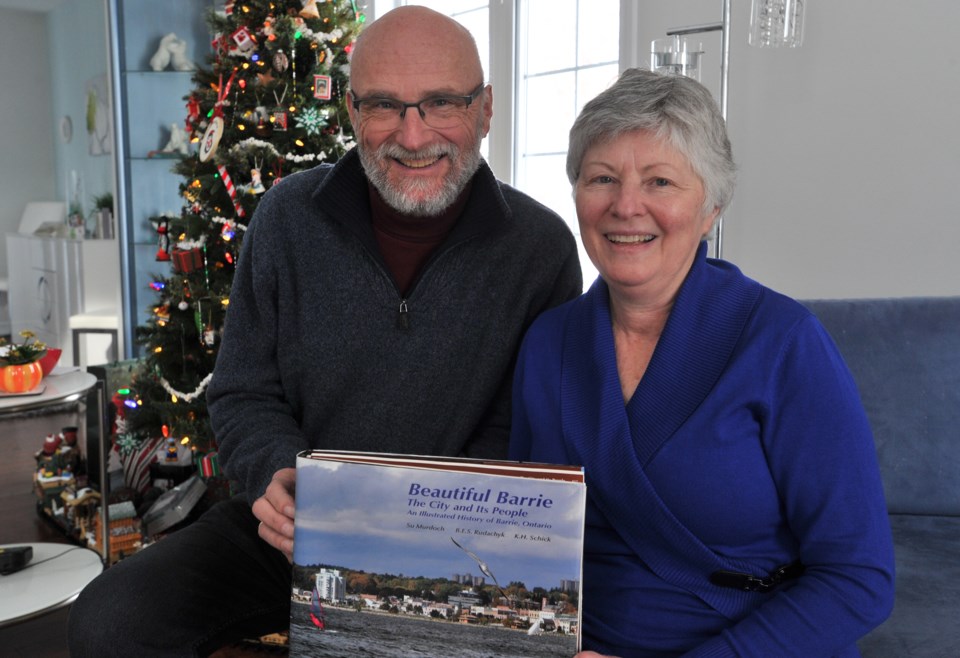The local historian, who holds a PhD in Canadian history, co-authored the book Beautiful Barrie, the City and Its People along with renowned historical archivist and heritage consultant Su Murdoch.
They, along with the late Kurt Schick, who designed the look of the book and was an author for McGraw-Hill Ryerson — writing educational books for high school and college students — created the 400-plus page tome which is a go-to guide for anyone interested about Barrie’s roots.
“It was collaborative project,” says Murdoch, who also worked at the Simcoe County Archives until 1990, adding that a lot of the early land records she referenced came from both there and the Ontario Archives as well as individual repositories.
Rudachyk interviewed people, or relatives of people, who had knowledge (some of it first-hand) of eras from the 19th and 20th centuries.
“You can’t rely wholly on oral history, as Brad can attest,” Murdoch says. “You still have to do the original research with the land records and pulling together the documentation. You have to do the research to understand the geography and the landscape that Barrie is."
Murdoch says delving deep into the city's history has given her a different perspective.
“When I walk around Barrie, I see it differently than a lot of people because I see the patterns of settlement, the historic districts and the added districts to see the landscape we have today,” she says. “You have to balance the documentation — the things you can prove and prove from several sources — and then layer it with the interest factor you can get out of an oral history.”
The book begins with the glacial age of the area, with some references to the original peoples of the area. But the main focus is on the European settlement of Barrie.
“We decided we would probably get the Indigenous occupation wrong and it would have a European perspective, so (hopefully) someday it will be written by someone who knows it best,” Murdoch says.
While the pages and pages of photos, stories, maps and more are basically a history of Barrie up until its designation as a city corporation in 1959, there are many, many references to the later 20th century and beyond until 2003, with most of the photography by Schick.
“The book is beautiful because of Kurt,” says Rudachyk. “He did all of the placement, all of the designing, fixed all of the (older) photographs.”
“Kurt was a perfectionist in his work,” adds Murdoch. “He kept driving us for more and more photographs and maps. He would enhance them so we could read them and he brought them to life.”
Longtime residents, newcomers and visitors will find Beautiful Barrie an intriguing read.
“The book is important because it gives people who are interested in Barrie’s past a place to start, people who have lived here for years and years and have family roots,” Rudachyk says. “But Barrie grew phenomenally in the early 1990s and so now we’ve got a whole bunch of new people who’ve come to Barrie.
“Rayner McCullough, who helped source a lot of the material, was talking to someone a few years ago and they were amazed to find out that Barrie was actually on the water,” he adds. “They lived in the south end and they had no idea that Barrie had a waterfront.”
Neither Murdoch nor Rudachyk make any claims that the book is the end-all, be-all of the city’s history, he says.
“We hope that there will be others who take this up, whether it be the Aboriginal history or the stuff we couldn’t cover that’s not there. We really wanted to have a starting place to get people interested and move forward,” Rudachyk says.
“It’s kind of a benchmark for people to understand how Barrie came to be, why people think the way they do: all those stories are there.”
Beautiful Barrie, the City and Its People is available at Cole’s, the Simcoe County Library and the MacLaren Art Centre.



